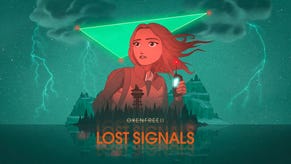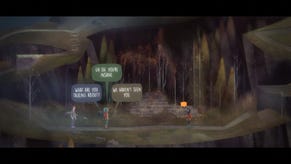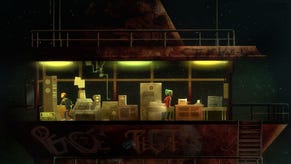Oxenfree II: Lost Signals review: a spooky, supernatural adventure that needs fine-tuning
Glooms day
I remember playing the first Oxenfree so clearly. The nervousness of not truly understating the supernatural forces its cast of troubled teens was up against, the heightened tension of uncovering the buried secrets of Edwards Island, and - what I loved the most - the finely tuned undercurrent of dread that quietly crept through the game. It conjured a sense of unease in me that I couldn't shake loose, and it was a feeling that clung to me throughout my entire playthrough.
So I was pretty stoked when Night School Studio announced Oxenfree 2: Lost Signals, a direct follow-up set five years after the original game. Lost Signals may take place in a new location with a new cast of characters, but there's still a lot of overlap. There are supernatural spooks, personal character drama, creepy radio equipment, and those good ol' screen glitches that I've missed so much. But with all these tethers to the first game, Lost Signals feels like a re-tread of the same ground. It's still a good sequel, I should add, but it's not a particularly satisfying one.
In Lost Signals, we follow Riley, an environmental researcher who's returned to her coastal hometown of Camena to investigate why some of the island's electronic equipment is going haywire. Enlisting the help of Camena resident and loveable dork Jacob, the two set off across the island and get caught up in a string of supernatural events. Turns out Camena is neighbours with Edwards Island, so cue the creepy cults, interdimensional tears in reality, and supernatural beings that can travel through space and time using radio static.
Night School’s speech bubble talk-and-walk system is back in full force, and I found myself quickly warming to this new duo. Awkward handyman Jacob is easy to like straight away. He's the kind of guy who makes junk art and complains about late library book fees. Riley takes more time. She's snarky, sarcastic and blunt in a way that initially comes across as abrasive, but eventually becomes refreshing. When the ghostly shenanigans of the island start to kick off, she’s also super pragmatic - definitely the kind of person I would want to be stuck on a haunted island with.
.jpg?width=690&quality=80&format=jpg&auto=webp)
Night School have always excelled at realistic conversations (seen in both the first Oxenfree and what they made next in Afterparty), and listening to these two opposing personalities shoot the shit was always humorous and endearing. When things got ultra spooky, their well-seeded backstories and motivations also helped its punches pack the right amount of emotional weight. The pair have a similar character arc in that they both feel like they’re drifting through life, not able to really find a purpose because of their respective pasts, but events in the game force them to reflect on their lives, and they each go through a transition that’s almost like a coming-of-age story for adults. I feel like we don't often get to see these kinds of age-bracket epiphanies in games very much - they're usually geared toward teens, as they are in other forms of media - so it was great to see it explored from the perspective of two actual adults here. Like, us adults have life shit that needs sorting out too, you know?
.jpg?width=690&quality=80&format=jpg&auto=webp)
When wandering from the beaten path you’ll often pick up people’s stray radio signals - a fisherman out at sea, a researcher interested in the paranormal, a cautious park ranger - and if you strike up a conversation with them and they’ll often give you a mini sidequest. When completed, a line of communication on your walkie-talkie will open up and you can chat with them about Camena's history and lore wherever you like.
Conversations keep the pace up as you walk from A to B, but Lost Signals struggles to thread the same needle as the first Oxenfree when it comes to its wider story ambitions. For example, at first, I thought Lost Signals was inviting me to make more active character decisions, rather than just talky decisions, but this never quite materialised in the rest of the game. There's a point where Riley royally fucks up a jump between two cliffs and falls 30 feet, for example - a risk I decided to take thinking it would be fun because, you know, video games - but she dusted herself off with no harm done. Sure, she got a thorough telling off from Jacob that felt like an implicit warning along the lines of "This could have been super bad so watch out for these kinds of decisions in the future!" but I never came across any other points like this during my playthrough. The same goes for the different routes you can take through each area. Choosing between them didn't hold any major consequences story-wise, which felt like a missed opportunity.
.jpg?width=690&quality=80&format=jpg&auto=webp)
Similarly, there are multiple endings and outcomes here that affect the characters in different ways, but unlike the first Oxenfree, these decisions didn't really impact the core of the sequel's story. They ended up not mattering much in the end, which was a bit of a bummer. As mentioned above, the individual character beats pack just the right amount of punch, but Lost Singal's broader tale of vengeful spirits and interdimensional portals falls flat. Riley and Jacob’s personal drama isn’t intertwined with the story like the teens in the first game, so it ends up feeling like they were simply two unlucky people caught up in something that doesn't have anything to do with them. For a game that deals with wibbly wobbly timey wimey antics, I was expecting a lot more time meddling, exploring the character’s personal histories and how it all ties to the present, but was ultimately left disappointed.
That doesn’t mean there aren’t some great thrills, though. As in the first game, the use of analogue tech for big spooks was fun, and messing with the walkie-talkies, broadcast transmitters, and radio signals was always suitably creepy. Tuning the radio to open a portal continues to make for some stand-out moments, and carefully using the mouse wheel to change the frequencies as the screen glitched and warped was cool. Listening to the static on the radio’s airwaves, I swear I could hear whispers. It was probably nothing, just my mind playing tricks on me, but it’s something that the atmosphere inspires, and it’s chilling.
.jpg?width=690&quality=80&format=jpg&auto=webp)
It’s something I wish Lost Signals sunk into more. Oxenfree’s atmosphere slowly crept up on you, but in Lost Signals the scares are much more explicit. It almost plays its cards too soon, as the spooky ghost antics revealed in the first hour are the same as those in the game’s dramatic final act, meaning there’s no real escalation of tension and horror. The first time I saw those horrible radio beings materialize from my radio frequency (I've chucked a screenshot above) was great! But it happened way too early in the game. The spook dial leapt from 0 to 100 without that all-important built-up.
Just as Edwards Island looms in the distance behind Camena, the original game looms over its successor. Lost Signals shares a lot of elements with what came before it, and it does those things well (good for a sequel) but it also feels like it doesn’t really expand on those ideas either (not so good for a sequel). If you like playing games for their atmosphere, then Oxenfree 2 will certainly tick a lot of boxes for you, but for fans of the first one looking for more, it's best to keep expectations in check.
This review is based on a review build of the game provided by the publisher Netflix.






